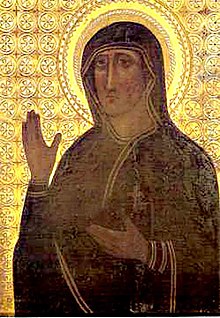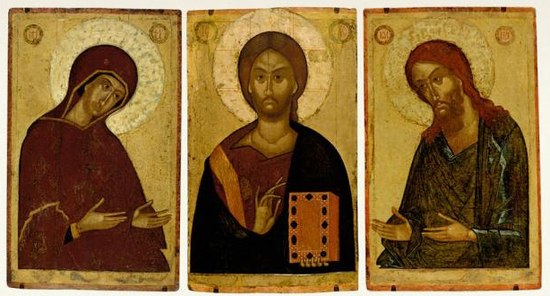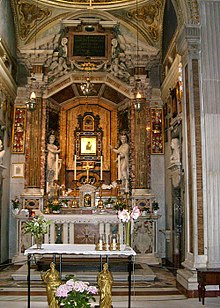Hagiosoritissa

The iconographic type of Hagiosoritissa , Haghiosoritissa or Agiosoritissa (Greek: Ἁγιοσορίτισσα) emerged in Byzantine art between the 5th and 7th centuries.
The name
This iconographic type received several names:
- Hagiosoritissa or Agiosoritissa (Ἁγιοσορίτισσα, to aghia , "holy", and soros , "shrine, urn"; therefore "the icon at the holy shrine"), because it was in the rotunda called Hagia Soros , where according to tradition since 5th century the veil ( maphorion ) and the sacred belt (zone), which the Mother of God found and venerated. Infertile and pregnant women and women in labor turned to the “holy belt”.
- Chalkopratissa, because the Agiosoritissa chapel was located in the Chalkoprateia church , one of the churches of Constantinople , in the Chalkoprateia district (Ξαλκοπρατει̑α, "copper market") 150 meters west of Hagia Sophia . The Zeynep Sultan Mosque now stands on the site of the Chalkoprateia Church .
- Paraklesis (Greek: παρακλησις) or invocation for their gesture of intercession.
iconography
The Hagiosoritissa is a variant of Maria orans and is shown on the side as a half-figure praying (without the baby Jesus ) with a tunic with tight sleeves up to the wrist and a cloak that is raised at the level of the arms.
Mary, whose head is turned slightly to the right, looks at the observer, even if her gaze is not as direct as in the Hodegetria . While her right hand is raised pleading with the invisible son, her left hand rests on her chest to indicate that she stands up for those who turn to her. That is why “Madonna Avvocata” or “Madonna Advocata” (“Madonna Advocate”) is also called. A diadem is depicted on her head. Opposite her (mostly raised) the hand of God or Christ as a half figure.
The variant enjoys great veneration in Rome , where there are a total of six different copies from different eras. They are allegedly all Madonnas of the Evangelist Luke , which is why they are also referred to under the name Madonna di San Luca (from Saint Luke).
history
Aelia Eudocia , wife of the Eastern Roman emperor Theodosius II , is said to have brought relics to Constantinople from her pilgrimage to Jerusalem in 438/439 . Among them should have been a miraculous image, the veil (Maphorion) and the belt (zone) of the Blessed Mother, which Aelia Eudocia later sent to her sister-in-law Aelia Pulcheria .
After the death of Theodosius II in 450, his older sister Aelia Pulcheria had three churches dedicated to the Mother of God built in different parts of Constantinople. The second church, the Chalkoprateia Church, was built by the Empress Aelia Pulcheria in the Chalkoprateia district ( ancient Greek Ξαλκοπρατει̑α , "copper market") west of the Hagia Sophia Church , where the belt of the Blessed Virgin was kept and venerated. Infertile and pregnant women and women in labor turned to the “holy belt”. The Zeynep Sultan Mosque now stands on the site of the Chalkoprateia Church . Over time, more and more images appeared this type that are already in the 7th century in art history a part of the so-called Deesis group (Greek .: "Please"; representation of the enthroned Christ between Mary and John the Baptist , to its sides interceding) were.
The name Hagiosoritissa is on three seals and on an icon from the 10th-13th centuries . Century read, which are preserved in the Monastery of St. Catherine on the Sinai .
The copies of the Hagiosoritissa from the 7th-13th centuries Century will be in Rome in the basilicas of Santa Maria in Aracoeli on the Capitol , Santi Bonifacio e Alessio , Santa Maria in Via Lata , San Lorenzo in Damaso and in the churches of Santa Maria del Rosario a Monte Mario and Santa Maria della Concezione in Campo Marzio kept .
Also in Tivoli in the Chiesa Santa Maria Maggiore there is a Madonna Hagiosoritissa from the 13th century.
The arrival of icons in Italy
There are many legends about the arrival of icons in Italy.
- The icon of Hagiosoritissa in the Chiesa Santa Maria del Rosario a Monte Mario is considered the oldest existing icon in Italy. According to tradition, it came from Constantinople at the end of the 4th or beginning of the 5th century. According to some scholars, it could have come from the Syrian - Palestinian territory (7th / 8th centuries). The restoration carried out in 1960 confirmed the icon's origins in the Middle East .
- According to information, the icon is said to have been in the Chiesa di Santa Maria in Tempulo in Via Valle delle Camene in the 9th century . On February 24, 1221, Saint Dominic had the icon brought to the Basilica of San Sisto Vecchio , where it was called Madonna di San Sisto (Madonna of San Sisto) and where it remained for 354 years until 1575.
- In 1527 the icon was miraculously found in the church, which was destroyed by mercenary armies in the sack of Rome . According to tradition, the end of the terrible scourge is attributed to the icon.
- On February 8, 1575, the raging malaria forced the Dominican women to move to the monastery of Santi Domenico e Sisto on the Quirinal .
- The icon of Hagiosoritissa in the basilica of Santa Maria in Aracoeli is said to have come from Jerusalem , was kept in the Chalkoprateia church in Constantinople and came to Rome in the 5th century.
- What is certain is that it has been in Rome since the 8th century. After the original was lost, the icon was replaced in the middle of the 10th century by one of the many copies that had been painted in the meantime. Examples of this icon can be found in Greece , Germany , Russia and other parts of Italy ; a famous mirror-image icon of this type can be found in the Cappella della Santissima Icone in the Cathedral of Santa Maria Assunta in Spoleto , Umbria .
- The icon is attributed to the end of the plague in Rome in 1348. Out of gratitude, a steep staircase with 124 marble steps was built from the Piazza d'Aracoeli to the west facade of the church. (Fig.) On May 30, 1948, this icon was dedicated to the city of Rome.
- The icon of Hagiosoritissa in the Chiesa Santa Maria della Concezione in Campo Marzio is said to have been brought to Rome by Calogere from Constantinople in 750 to escape iconoclastic persecution. Pope Zacharias (741–752), who was of Greek origin, allowed them to settle in Campo Marzio near a church dedicated to the Madonna.
- According to tradition, the icon of Hagiosoritissa in the Basilica of Santi Bonifacio e Alessio is said to have been brought to Rome at the end of the 10th century by Metropolitan Sergius from Damascus, who had fled the Arabs, where he founded the monastery of San Alessio on the Aventine in 977 and granted asylum to Greek monks who had fled.
See also
literature
- Lorenzo Ceolin: L'iconografia dell'immagine della madonna . Storia e Letteratura, Rome 2005, ISBN 88-8498-155-7 , p. 41 (Italian, online version (preview) in Google Book Search).
- Raimondo Spiazzi: La chiesa e il monastero di San Sisto all'Appia: raccolta di studi storici . Edizioni Studio Domenicano, Bologna 1992, ISBN 978-88-7094-124-1 (Italian, online version (preview) in Google Book Search).
Web links
- Hagiosoritissa. In: Rdklabor.de. Retrieved August 11, 2017 .
- Icon in Roma attribuite, per tradizione, a san Luca. In: Piccoloeremodellequerce.it. Retrieved August 12, 2017 (Italian).
Individual evidence
- ↑ Franz Slump: God's Wrath - Mary's Protection. Plague images and related representations as an iconographic expression of late medieval piety and as a theological problem . Münster 2000, The protective mantle of the Madonna in Orthodox Christianity, p. 3.2.6 . ( slump.de ).
- ↑ a b c d e Raimondo Spiazzi, p. 139
- ↑ Patrizia Morelli, Silverio Saulle: Anna Comnena: la poetessa epica (c. 1083 – c. 1148–1153) . Jaca Book SpA, Milan 1998, ISBN 88-16-43506-2 , pp. 27 (Italian, online version in Google Book Search).
- ↑ a b c d e f g h i Icone in Roma attribuite, per tradizione, a san Luca
- ↑ Quel capolavoro di Dio. In: Stpauls.it. Retrieved July 30, 2017 (Italian).
- ↑ a b Lorenzo Ceolin, p. 41
- ↑ Rdklabor.de
- ↑ Sercan Yandım: The icons from the museums in Antalya and Tokat in Turkey . VDM Verlag Dr. Müller, Saarbrücken 2008, p. 52 ( d-nb.info ).
- ↑ Church of St Mary Chalkoprateia Istanbul. In: Veryturkey.com. Retrieved June 9, 2017 .
- ↑ Patrizia Morelli, Silverio Saulle: Anna Comnena: la poetessa epica (c. 1083 – c. 1148–1153) . Jaca Book SpA, Milan 1998, ISBN 88-16-43506-2 , pp. 27 (Italian, online version in Google Book Search).
- ↑ Quel capolavoro di Dio. In: Stpauls.it. Retrieved July 30, 2017 (Italian).
- ↑ La Madonna delle Grazie. In: Tibursuperbum.it. Retrieved June 12, 2017 (Italian).
- ^ Friedrich Prinz: Basics and Beginnings, Germany until 1056 . CH Beck, Mènchen 1993, ISBN 978-3-406-37930-7 , pp. 171 ( online version in Google Book Search).










